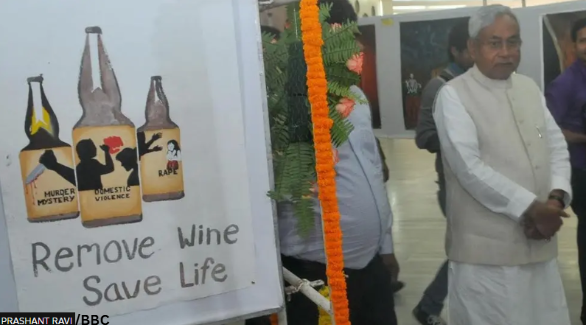– Md. Sami Ahmad
Patna: Recently, the Bihar Police claimed that the state’s liquor prohibition, implemented in 2016, has played a role in reducing the number of communal riots. While many acknowledge that the ban has helped curb petty crimes such as domestic violence, the assertion regarding a decline in communal violence has been met with scepticism.
Critics point out that the data released by the police initially refers to “communal riots,” but later mentions only “riots,” omitting the communal aspect. This shift in terminology suggests that the reported decrease pertains to general riot incidents, which may or may not include communal cases.
The timing of the police’s statement is notable. Chief Minister Nitish Kumar’s party, JD(U), has come under heavy criticism from Muslim groups and secular circles for supporting the controversial Waqf (Amendment) Bill, now enacted into law. Though Muslim religious leaders had previously backed the liquor ban and continue to do so, there is growing debate over whether it has significantly reduced communal violence.
According to Bihar Police, riot incidents have been steadily declining over the past two decades, dropping from 9,199 in 2004 to 3,186 in 2024 – a threefold decrease. They attribute this trend to two major initiatives: the 2016 liquor prohibition law and the launch of the Dial-112 emergency response system in 2021.
Data from the police headquarters shows that riot cases rose from 8,520 in 2001 to 9,199 in 2004, peaking at 13,311 in 2015. After the liquor ban was enacted, the number dropped to 11,617 in 2016. Notably, the data does not specify whether these were communal in nature. Following the introduction of Dial-112, incidents fell sharply – from 9,419 in 2020 to 6,298 in 2021, and further to 3,186 by 2024.
Explaining the role of Dial-112, the Bihar Police stated that officers now respond to emergency calls within 15 to 20 minutes. “During riot-related incidents, swift police action often prevents escalation. Even in rare instances where the police are outnumbered, they manage to regain control and prevent serious harm,” the department said.
Director General of Police Vinay Kumar emphasised that both the liquor ban and Dial-112 have been instrumental in reducing riot cases. “There has been a consistent decline,” he said, citing rigorous monitoring, rapid arrests, and expedited legal action.
However, the claim that prohibition directly reduced communal riots is contentious. While Chief Minister Nitish Kumar insists that communal riots have ceased under his leadership, supported by enhanced communal harmony and a drop in certain crimes, others caution against drawing definitive conclusions.
AI Grok notes that some studies suggest prohibition has reduced violence related to alcohol – such as domestic abuse and public altercations – thereby fostering a calmer environment that may help lower communal tensions. National Family Health Survey data supports a decrease in alcohol consumption and intimate partner violence post-ban, potentially contributing to broader social stability.
Yet, incidents like the 2018 Ram Navami riots, which affected multiple districts, indicate that communal tensions persist. These events were largely attributed to organised provocations and religious polarisation, rather than alcohol-related factors.
Professor Abdul Qadir, a longtime observer of Nitish Kumar, argues that prohibition’s success is overstated. “Liquor hasn’t disappeared – it’s just shifted from over-the-counter sales to home delivery. With rising arrests and seizures, it’s clear that prohibition in Bihar is more symbolic than real. And if the policy itself is flawed, its claimed outcomes become questionable,” he said.
In contrast, Professor Shamim Ahmad Munemi sees visible benefits from the liquor ban. “There’s a clear drop in crimes where alcohol was a contributing factor. I also believe that prohibition has helped reduce communal riots,” he stated. While he acknowledges implementation gaps, he maintains that “even partial enforcement is bringing peace. A fully enforced prohibition would have an even greater impact.”
Social activists offer a more cautious view. They argue that while prohibition may ease some interpersonal tensions, communal riots in Bihar often stem from deeper issues – religious polarisation, political manipulation, and socioeconomic inequality – that a liquor ban cannot address. The 2018 riots, for example, were driven by coordinated efforts to incite unrest, not spontaneous alcohol-fuelled violence.
In summary, while prohibition may have contributed to an overall reduction in crime and fostered a calmer social climate, the evidence for a direct causal link to decreased communal riots remains inconclusive. Many believe the policy has had indirect benefits, but others stress the need to tackle root causes beyond alcohol consumption to achieve lasting communal harmony.




